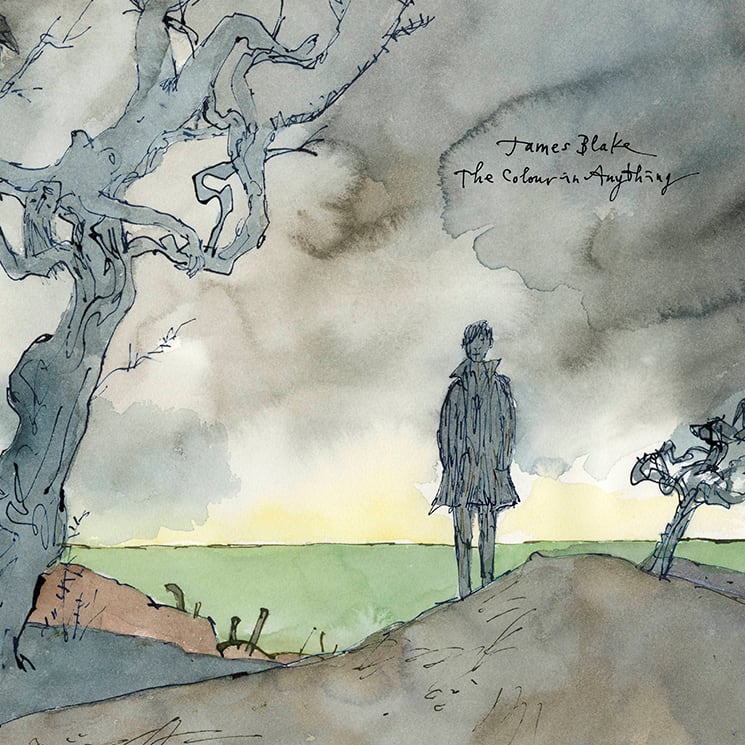The idea of romantic love and the question of its existence have always been present in the music of James Blake. It's an emotion that he explored in depth both with 2013's Overgrown and on his self-titled debut, which featured popular reinterpretations of work from Joni Mitchell, Feist and his own father, but at no other point has Blake unpacked and deconstructed the myriad feelings and facets behind love as deeply as he does on The Colour in Anything, his incredibly expansive third record.
Blake's music and lyrics here speak to a deteriorating romantic relationship, which can also be gleaned from the illustrated cover, which depicts a woman ensnared amongst the gnarled branches of a tree. It likely references his own experience with Warpaint's Theresa Wayman, in whom he lost not just a lover but a creative partner (she helped arrange Overgrown). The Colour in Anything follows post-breakup themes of denial, sadness, acceptance and a will to start anew, at one point shifting from the rainy streets of London, where Blake's compositions feel right at home, to Rick Rubin's Shangri La Studios in sunny Malibu, where a portion of the record was recorded.
The London darkness is most dominant in the record's first half, established with the circular verse/chorus structure of "Radio Silence." Blake's emotionally loaded, sometimes repetitive lyrics — "I can't believe this / You don't want to see me," and "But in my heart / There's a radio silence going on" — might fall on some weary ears, but they'll remain effective mantras for others, their importance and meaning only amplified by the layered instrumentation rising and falling around them.
This writing device persists throughout the record: "I suggest you love like love's no loss" he sings over and over on "Waves Know Shores"; "I want it to be over," he repeatedly wishes in harmony on "Modern Soul." It reaches its apex with "Choose Me," on which Blake reaches almost shouting volume with the repetitive plea "I'd rather you choose me," as he's backed by a vocoder doing the same amidst a flurry of electronics.
Blake moves even deeper when left alone with the piano, as evidenced by the aching chord changes of "f.o.r.e.v.e.r.," the soulful title track and the stunning Frank Ocean co-written, jazz-leaning "My Willing Heart," which pointedly captures the dating malaise of the modern generation with the simple thought, "you're still on my screen."
But The Colour in Anything is far from just doom and gloom for Blake, who calls for growth and rebirth on "I Need A Forest Fire" alongside friend and collaborator Justin Vernon. From that point forward, uplifting moments within "Two Men Down," "Modern Soul" and "Always" part the clouds for "Meet You in the Maze," an a cappella of self-reflection in which he realizes that "music can't be everything."
From its weighty subject matter to its incredibly nuanced production, The Colour in Anything is not only Blake at his best, but also his most personal. Blake's expanded his both his heart and his process here, making music with others outside of his laptop to demonstrate the growth that had led to this brilliant, fulfilling work.
(Universal)Blake's music and lyrics here speak to a deteriorating romantic relationship, which can also be gleaned from the illustrated cover, which depicts a woman ensnared amongst the gnarled branches of a tree. It likely references his own experience with Warpaint's Theresa Wayman, in whom he lost not just a lover but a creative partner (she helped arrange Overgrown). The Colour in Anything follows post-breakup themes of denial, sadness, acceptance and a will to start anew, at one point shifting from the rainy streets of London, where Blake's compositions feel right at home, to Rick Rubin's Shangri La Studios in sunny Malibu, where a portion of the record was recorded.
The London darkness is most dominant in the record's first half, established with the circular verse/chorus structure of "Radio Silence." Blake's emotionally loaded, sometimes repetitive lyrics — "I can't believe this / You don't want to see me," and "But in my heart / There's a radio silence going on" — might fall on some weary ears, but they'll remain effective mantras for others, their importance and meaning only amplified by the layered instrumentation rising and falling around them.
This writing device persists throughout the record: "I suggest you love like love's no loss" he sings over and over on "Waves Know Shores"; "I want it to be over," he repeatedly wishes in harmony on "Modern Soul." It reaches its apex with "Choose Me," on which Blake reaches almost shouting volume with the repetitive plea "I'd rather you choose me," as he's backed by a vocoder doing the same amidst a flurry of electronics.
Blake moves even deeper when left alone with the piano, as evidenced by the aching chord changes of "f.o.r.e.v.e.r.," the soulful title track and the stunning Frank Ocean co-written, jazz-leaning "My Willing Heart," which pointedly captures the dating malaise of the modern generation with the simple thought, "you're still on my screen."
But The Colour in Anything is far from just doom and gloom for Blake, who calls for growth and rebirth on "I Need A Forest Fire" alongside friend and collaborator Justin Vernon. From that point forward, uplifting moments within "Two Men Down," "Modern Soul" and "Always" part the clouds for "Meet You in the Maze," an a cappella of self-reflection in which he realizes that "music can't be everything."
From its weighty subject matter to its incredibly nuanced production, The Colour in Anything is not only Blake at his best, but also his most personal. Blake's expanded his both his heart and his process here, making music with others outside of his laptop to demonstrate the growth that had led to this brilliant, fulfilling work.




